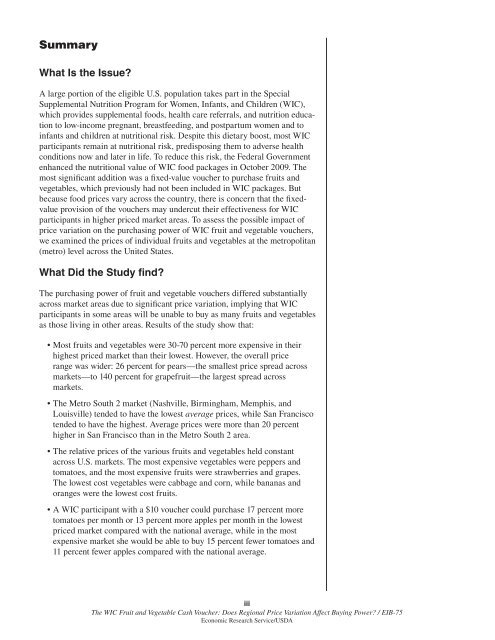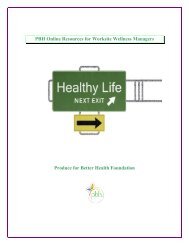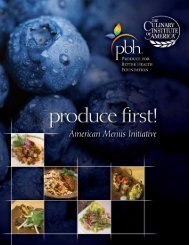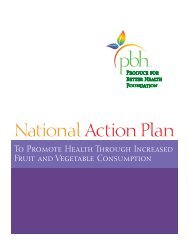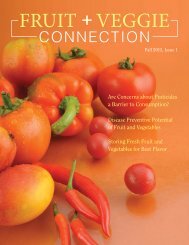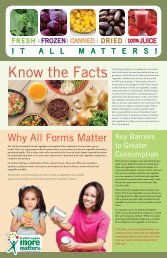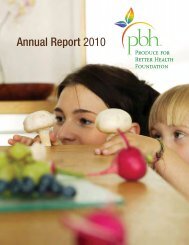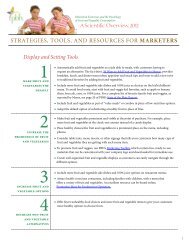The WIC Fruit and Vegetable Cash Voucher - Produce for Better ...
The WIC Fruit and Vegetable Cash Voucher - Produce for Better ...
The WIC Fruit and Vegetable Cash Voucher - Produce for Better ...
You also want an ePaper? Increase the reach of your titles
YUMPU automatically turns print PDFs into web optimized ePapers that Google loves.
SummaryWhat Is the Issue?A large portion of the eligible U.S. population takes part in the SpecialSupplemental Nutrition Program <strong>for</strong> Women, Infants, <strong>and</strong> Children (<strong>WIC</strong>),which provides supplemental foods, health care referrals, <strong>and</strong> nutrition educationto low-income pregnant, breastfeeding, <strong>and</strong> postpartum women <strong>and</strong> toinfants <strong>and</strong> children at nutritional risk. Despite this dietary boost, most <strong>WIC</strong>participants remain at nutritional risk, predisposing them to adverse healthconditions now <strong>and</strong> later in life. To reduce this risk, the Federal Governmentenhanced the nutritional value of <strong>WIC</strong> food packages in October 2009. <strong>The</strong>most significant addition was a fixed-value voucher to purchase fruits <strong>and</strong>vegetables, which previously had not been included in <strong>WIC</strong> packages. Butbecause food prices vary across the country, there is concern that the fixedvalueprovision of the vouchers may undercut their effectiveness <strong>for</strong> <strong>WIC</strong>participants in higher priced market areas. To assess the possible impact ofprice variation on the purchasing power of <strong>WIC</strong> fruit <strong>and</strong> vegetable vouchers,we examined the prices of individual fruits <strong>and</strong> vegetables at the metropolitan(metro) level across the United States.What Did the Study find?<strong>The</strong> purchasing power of fruit <strong>and</strong> vegetable vouchers differed substantiallyacross market areas due to significant price variation, implying that <strong>WIC</strong>participants in some areas will be unable to buy as many fruits <strong>and</strong> vegetablesas those living in other areas. Results of the study show that:• Most fruits <strong>and</strong> vegetables were 30-70 percent more expensive in theirhighest priced market than their lowest. However, the overall pricerange was wider: 26 percent <strong>for</strong> pears—the smallest price spread acrossmarkets—to 140 percent <strong>for</strong> grapefruit—the largest spread acrossmarkets.• <strong>The</strong> Metro South 2 market (Nashville, Birmingham, Memphis, <strong>and</strong>Louisville) tended to have the lowest average prices, while San Franciscotended to have the highest. Average prices were more than 20 percenthigher in San Francisco than in the Metro South 2 area.• <strong>The</strong> relative prices of the various fruits <strong>and</strong> vegetables held constantacross U.S. markets. <strong>The</strong> most expensive vegetables were peppers <strong>and</strong>tomatoes, <strong>and</strong> the most expensive fruits were strawberries <strong>and</strong> grapes.<strong>The</strong> lowest cost vegetables were cabbage <strong>and</strong> corn, while bananas <strong>and</strong>oranges were the lowest cost fruits.• A <strong>WIC</strong> participant with a $10 voucher could purchase 17 percent moretomatoes per month or 13 percent more apples per month in the lowestpriced market compared with the national average, while in the mostexpensive market she would be able to buy 15 percent fewer tomatoes <strong>and</strong>11 percent fewer apples compared with the national average.iii<strong>The</strong> <strong>WIC</strong> <strong>Fruit</strong> <strong>and</strong> <strong>Vegetable</strong> <strong>Cash</strong> <strong>Voucher</strong>: Does Regional Price Variation Affect Buying Power? / EIB-75Economic Research Service/USDA


